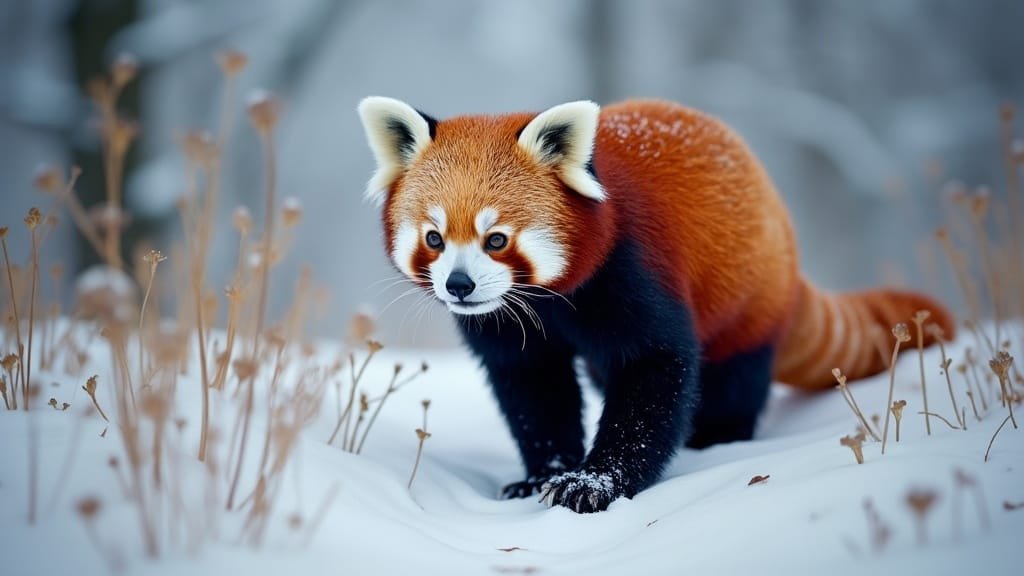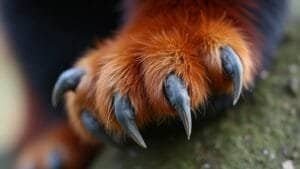Red pandas, native to the high-altitude forests of the Himalayas and parts of China, are perfectly adapted to their cold and snowy environments. One of their most essential survival traits is their thick coat of fur, which provides insulation, water resistance, and protection against extreme temperatures
This dense fur helps red pandas thrive in habitats where winter temperatures often drop below freezing, shielding them from snow, rain, and icy winds. In this article, we’ll explore the functions of the red panda’s thick coat, how it supports their survival in cold climates, and the evolutionary adaptations that have allowed these fascinating mammals to flourish in challenging environments
The Functions of the Red Panda’s Thick Fur

The red panda’s thick fur is one of its most vital adaptations, allowing it to survive in the cold, high-altitude forests of the Himalayas. This fur is uniquely designed to serve multiple functions, from providing insulation to repelling water and adapting to seasonal temperature changes
Insulation Against Cold Temperatures
Red pandas inhabit regions where winter temperatures can drop well below freezing, often reaching as low as 23°F. Their thick fur provides the insulation needed to maintain a stable body temperature in these frigid conditions. The coat consists of two layers: an outer layer of coarse, long hairs that trap heat and block cold winds, and a dense underlayer that retains warmth by trapping air close to the body
Research by Pradhan et al. (Journal of Mammalogy, 2001) highlights the importance of this dual-layered fur structure, which helps the red panda conserve body heat while resting in the open during winter. This fur adaptation minimizes the energy expenditure required to generate warmth, making it especially advantageous for an animal that relies on bamboo, a low-calorie food source, for sustenance
Water Resistance for Survival in Wet Environments
The red panda’s outer fur layer has a slightly oily texture, making it water-resistant. This feature is particularly useful in their native habitat, where snow and rain are common. By preventing moisture from seeping into the underlayer, the outer coat keeps the red panda’s skin dry and reduces the risk of hypothermia
A study published by Roberts and Gittleman (Mammalian Biology, 2020) noted that this water-repellent quality enables red pandas to remain active in snowy environments without becoming wet or losing body heat. Additionally, their fur prevents snow from accumulating on their bodies, ensuring that they can navigate their surroundings efficiently even in heavy snowfall
Seasonal Adaptation to Temperature Changes
The red panda’s fur is versatile, adapting to the seasonal temperature fluctuations of its habitat. In colder months, the dense underlayer provides critical insulation, while the coarse outer hairs protect against icy winds and precipitation. During warmer seasons, the fur’s ability to regulate temperature ensures that the red panda does not overheat, despite its thick coat
This adaptability allows red pandas to thrive in an environment where temperatures can range from 23°F in winter to 77°F in summer. According to the Red Panda Network, the dual-functionality of their fur is a direct response to the unpredictable climate of the Himalayas, giving them a survival advantage over other mammals that are less equipped to handle such extreme variations
For further information on how red pandas’ thick fur supports their survival in snowy conditions, you can refer to the Red Panda Network’s article on snow adaptation
How the Red Panda’s Fur Supports Its Survival

The red panda’s thick fur is more than just a source of warmth—it is a key feature that supports its survival in multiple ways. From protection against extreme weather to energy conservation and predator avoidance, the fur is finely adapted to the challenges of the red panda’s high-altitude habitat
Protection Against Extreme High-Altitude Conditions
The Himalayan forests, where red pandas are found, are characterized by high altitudes ranging from 7,200 to 13,800 feet. At these elevations, red pandas face harsh environmental conditions, including low oxygen levels, cold winds, and frequent snowfall. Their dense fur provides the necessary protection to endure these extremes
Studies by Yonzon et al. (Biological Conservation, 1987) observed that red pandas are capable of remaining active even during heavy snowstorms, thanks to their fur’s insulating properties. The combination of a dense underlayer and a water-resistant outer layer prevents cold air and moisture from reaching their skin, enabling them to forage and move without risking hypothermia
The red panda’s fur is especially effective at shielding exposed areas like its face, ears, and paws. This protective feature allows the animal to remain comfortable even when temperatures plummet or during windy conditions at higher altitudes
Energy Conservation and Its Importance
Energy conservation is critical for red pandas, as they rely heavily on bamboo, a low-calorie food source, for their diet. Their fur plays a significant role in reducing energy expenditure by insulating their bodies and minimizing heat loss
Research by Pradhan et al. (Journal of Mammalogy, 2001) found that the insulation provided by the fur helps red pandas maintain their body temperature with minimal metabolic effort. This adaptation is particularly important during the winter months, when food may be scarcer, and the energy demands for staying warm are higher
Additionally, their fur allows red pandas to remain stationary for long periods without losing body heat. By reducing their need for constant movement to generate warmth, they can conserve energy for essential activities like foraging and climbing
Camouflage and Predator Avoidance
The red panda’s fur also provides effective camouflage, which is essential for avoiding predators such as snow leopards, clouded leopards, and birds of prey. The reddish-brown coloration of their coat blends seamlessly with moss-covered tree trunks and the dappled sunlight of the forest canopy, making them difficult to spot
A study by Choudhury (Journal of Zoology, 2001) noted that the red panda’s ability to remain motionless while blending into its environment is a highly effective defense mechanism. Predators that rely on movement or visual contrast to locate prey are less likely to detect the red panda, allowing it to avoid confrontation
The alternating red and white rings on the red panda’s tail add to this camouflage effect, particularly when viewed from below. These markings mimic the way light filters through the trees, further enhancing their ability to stay hidden from aerial predators
For additional insights into how the red panda’s fur contributes to its survival strategies, you can visit the International Fund for Animal Welfare’s page on red pandas
Evolutionary and Regional Adaptations of the Red Panda’s Fur

The thick fur of the red panda is a product of millions of years of evolutionary development, finely tuned to meet the challenges of its unique environment. Additionally, regional variations in fur thickness reflect local climate adaptations, and comparisons with other cold-adapted mammals highlight the efficiency of the red panda’s coat
Evolutionary Advantages of Dense Fur
Over time, red pandas have evolved their dense fur to survive in the harsh and unpredictable conditions of their high-altitude habitat. The reddish-brown coloration provides camouflage among moss-covered tree trunks and lichen, while the thickness of their coat offers critical insulation during extreme cold
A comparative study conducted by Wei et al. (Journal of Mammalogy, 2014) revealed that red pandas with denser fur were more likely to survive harsh winters and reproduce successfully. This natural selection process favored individuals with superior thermal insulation, leading to the development of their distinct dual-layered coat
Their bushy tails, which serve both as insulation and balance tools, also evolved alongside their fur to complement their arboreal lifestyle. This adaptation enhances their survival in an ecosystem where tree-dwelling is a key strategy for avoiding predators and foraging for bamboo
Regional Variations in Fur Thickness
Red pandas across their range show slight regional variations in the density and thickness of their fur. Populations at higher elevations, such as those in Nepal and Bhutan, tend to have thicker coats to cope with colder temperatures and heavier snowfall. By contrast, red pandas in lower-altitude forests of China may have slightly thinner fur, reflecting the milder conditions of their habitat
A field study by Yonzon et al. (Biological Conservation, 1987) compared red panda populations in different regions and found that their fur thickness was directly correlated with local climate conditions. These regional adaptations ensure that red pandas remain well-suited to their specific environments, demonstrating the flexibility of their evolutionary traits
Comparison of Red Pandas’ Fur with Other Mammals
The red panda’s fur is comparable to that of other cold-adapted mammals, but it has unique features tailored to its arboreal lifestyle. For instance, its fur is denser than that of raccoons, which share a similar size and body structure but lack the same level of insulation
When compared to larger mammals like snow leopards or Arctic foxes, the red panda’s fur performs a similar function by providing warmth and protection from snow and wind. However, the red panda’s reliance on trees sets it apart; its fur must also offer flexibility and lightness to support movement among branches
According to Roberts and Gittleman (Mammalian Biology, 2020), the water-resistant quality of the red panda’s fur is more akin to that of otters, which also need to remain dry and insulated in wet environments. This comparison underscores the red panda’s adaptability, as it combines traits seen in both terrestrial and aquatic mammals to thrive in its unique ecological niche
For a detailed exploration of how red pandas’ fur compares to other mammals, you can check the WWF article on panda adaptations













